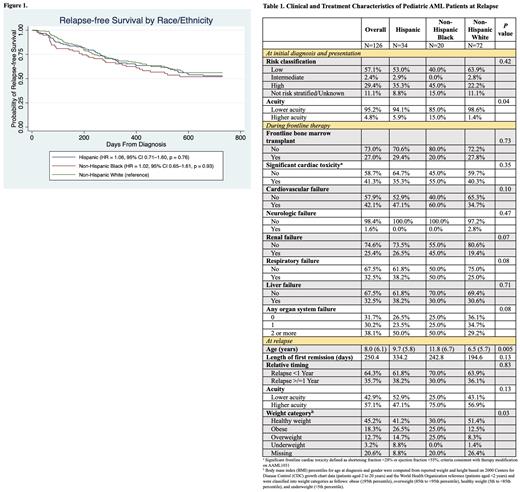Introduction: Racial and ethnic disparities in survival outcomes exist in pediatric acute myeloid leukemia (AML), but the role of relapse and its potential contribution to outcome disparities is unknown. We sought to examine differences in relapse-free survival (RFS) and clinical characteristics at the time of relapse by race and ethnicity using a real-world multi-institution cohort of pediatric AML patients.
Methods: A retrospective cohort including all pediatric (age <19 years) patients treated for AML from 2011-2019 at 13 institutions in the United States was established and is being actively expanded to include diagnoses through 2023. Data collection was accomplished by detailed chart abstraction performed by trained study personnel. We additionally merged resource utilization data from the Pediatric Health Information System to ascertain patient acuity and cumulative organ toxicity. Analyses were restricted to patients identified in the medical record as Hispanic, non-Hispanic Black (NHB), and non-Hispanic White (NHW) to specifically assess historically marginalized patient populations. Other racial/ethnic groups including multi-racial were excluded due to small numbers. Kaplan-Meier survival curves were generated for RFS by race/ethnicity. Adjusted Cox models compared the hazard of relapse by race/ethnicity. Models adjusted for age at diagnosis, sex, initial risk classification, weight category at diagnosis, and acuity at initial presentation. To assess misspecification of outcome, we performed sensitivity analyses restricted to relapses occurring within 1 year of diagnosis (early RFS). Among the patients who relapsed, descriptive frequencies for clinical and treatment characteristics were reported by race/ethnicity.
Results: A total of 437 pediatric patients with AML (28% Hispanic, 18% NHB, median follow-up time 3.0 years) were included in the analytic cohort. There were no statistically significant differences in RFS or early RFS by race/ethnicity (Figure 1). However, among relapsed patients, important qualitative differences were noted at the time of relapse (Table 1). Hispanic and NHB patients were older at relapse than NHW patients. Greater proportions of Hispanic and NHB patients (compared to NHW) experienced cardiovascular, respiratory, and renal failure during frontline therapy. Cumulative prevalence of organ failure in 2 or more systems since initial diagnosis was higher for both Hispanic (50%) and NHB (50%) patients compared to NHW patients (29%). Overweight/obesity at relapse was more prevalent among Hispanic (41%) and NHB (50%) compared to NHW (21%) patients. NHB patients were also more likely to present at relapse with higher acuity, defined as requiring ICU-level resources for 2 or more organ systems within 72 hours of admission, compared to NHW patients (75% vs. 57%).
Conclusions: Our data suggest a similar risk of relapse by race and ethnicity. However, differences in cumulative frontline organ toxicity and acuity of presentation may lead to differential treatment at the time of relapse and drive subsequent overall survival disparities for Hispanic and NHB patients with pediatric AML.
Future Directions: This was a planned interim analysis, and chart abstraction is ongoing to expand this cohort (anticipated N ~1000). We intend to pursue a series of formal mediation analyses regarding the role of relapse, cumulative organ toxicity during frontline treatment, and selection of salvage regimen on disparities in survival outcomes with the expanded cohort.
Disclosures
Elgarten:Allovir: Other: one time advisory committee. Fisher:Pfizer: Research Funding; Merck: Research Funding; Allovir: Research Funding; Astellas: Other: Membership on Data safety monitoring board.


